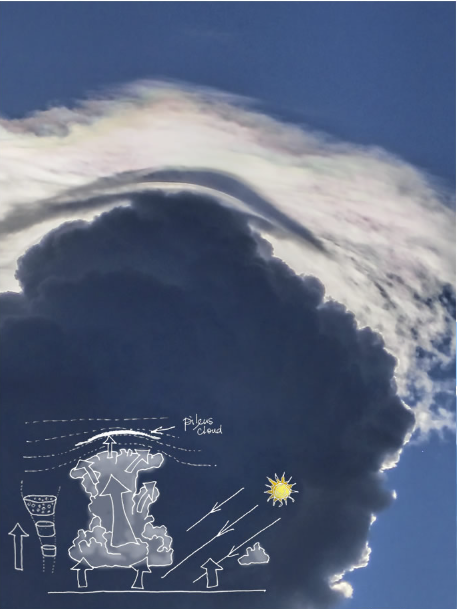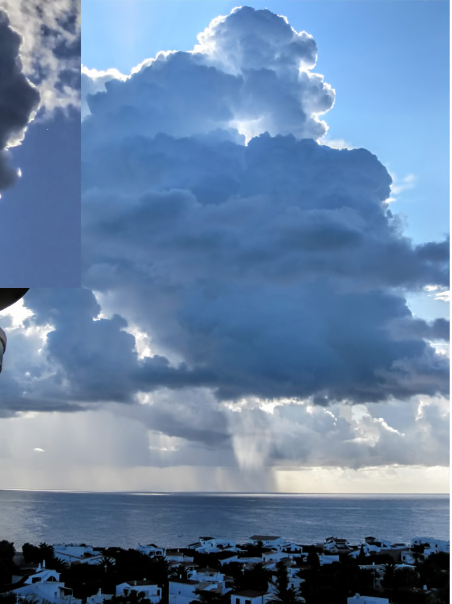Pileus & Iridescence - OPOD
Pileus & Iridescence: A Spectacular Atmospheric Phenomenon
Have you ever looked up at the sky and been captivated by the ethereal beauty of clouds? Sometimes, nature treats us to extraordinary displays of atmospheric optics, such as the mesmerizing combination of pileus clouds and iridescence. In this article, we will delve into the intricacies of these fascinating phenomena and explore the science behind their formation.
The Enigmatic Pileus Cloud
The story begins on a hot and humid day, where warm air rises from the sun-heated ground. As this air ascends, it expands and cools. If the humidity is sufficiently high, moisture condenses out of the air to form cumulus clouds. These cumulus clouds continue to grow upwards throughout the day, with more and more condensation taking place. In some instances, this upward motion becomes so intense that it leads to the development of towering cumulus clouds several kilometers high.
As the towering cumulus clouds surge upwards, they push the air layers above them even higher. If these upper layers contain moisture, the sudden expansion and cooling caused by the upward motion result in the rapid condensation of a thin cloud of droplets known as a pileus cloud. The pileus cloud appears as a cap-like formation above the cumulus cloud, casting a dark silhouette against the backlit sky.
The Allure of Iridescence
What makes pileus clouds even more enchanting is their tendency to exhibit iridescence. Iridescence refers to the phenomenon where certain surfaces or materials appear to change color as the angle of observation or illumination changes. In the case of pileus clouds, the rapid condensation process leads to the formation of droplets that are all of similar size and lack sufficient time to evolve.
These uniform droplets serve as ideal diffractors of sunlight at high altitudes, creating a dazzling display of bright iridescence. The diffraction of sunlight by these droplets causes the light to scatter and interfere, resulting in the appearance of vibrant colors that seem to dance across the cloud's surface.
Captivating Images of Pileus Clouds and Iridescence
Photographers and sky enthusiasts have been fortunate enough to capture breathtaking images of pileus clouds and iridescence. One such example is the work of Tim Anderson, who captured an image of a cap cloud surrounded by iridescent clouds. In his photograph, the cap cloud stands out in dark silhouette against the iridescent backdrop. It is important to note that cap clouds themselves often display strong iridescence, adding to the spectacle of this atmospheric phenomenon.
Appreciating Nature's Wonders
The occurrence of pileus clouds and iridescence serves as a reminder of the awe-inspiring beauty and complexity of our atmosphere. These atmospheric optics phenomena are not only visually captivating but also provide valuable insights into the physics and dynamics of cloud formation. By studying these phenomena, scientists can deepen their understanding of the intricate processes that shape our atmosphere and influence weather patterns.
Conclusion
In conclusion, pileus clouds and iridescence form a remarkable duo in the realm of atmospheric optics. The interplay between the rapid condensation process that gives rise to pileus clouds and the diffraction of sunlight by uniform droplets creates a mesmerizing display of iridescence. These captivating phenomena remind us of the intricacies of our atmosphere and the wonders that nature has in store for us. So, next time you gaze up at the sky, keep an eye out for these enchanting displays and marvel at the beauty of our ever-changing atmosphere.

Pileus (Cap Cloud)
Tim Anderson imaged this cap cloud formed over a towering cumulus mass. The clouds are backlit and the cap cloud is seen dark in silhouette. It appears to be surrounded by iridescent clouds, these are actually slightly lower and the cap cloud is seen through them.
Cap clouds are themselves often strongly iridescent.
Images ©Tim Anderson, shown with permission

The story of thin and translucent pileus (cap cloud) starts with the development of lower and much thicker cumulus on a hot and humid day.
Warm air rises from sun heated ground. It expands and cools as it climbs. If its humidity is sufficient then moisture condenses out to form cumulus cloud. As the day proceeds the cloud grows upwards with yet more condensation. The condensation releases heat which accelerates further the upward motions in the unstable mass. In extremis we get a thunderous cloud mass towering several kilometres.
All this also pushes the air layers above the cloud tops upwards. If a layer is moist then the upward travel causes expansion, cooling and sudden condensation into a thin cloud of droplets - a pileus cloud.
The rapid condensation into pileus is important. The droplets are all of similar size and do not have time to evolve. Ideal material to diffract the high altitude sunlight into bright iridescence.
Note: this article has been automatically converted from the old site and may not appear as intended. You can find the original article here.
Reference Atmospheric Optics
If you use any of the definitions, information, or data presented on Atmospheric Optics, please copy the link or reference below to properly credit us as the reference source. Thank you!
-
<a href="https://atoptics.co.uk/blog/pileus-iridescence-opod/">Pileus & Iridescence - OPOD</a>
-
"Pileus & Iridescence - OPOD". Atmospheric Optics. Accessed on November 26, 2024. https://atoptics.co.uk/blog/pileus-iridescence-opod/.
-
"Pileus & Iridescence - OPOD". Atmospheric Optics, https://atoptics.co.uk/blog/pileus-iridescence-opod/. Accessed 26 November, 2024
-
Pileus & Iridescence - OPOD. Atmospheric Optics. Retrieved from https://atoptics.co.uk/blog/pileus-iridescence-opod/.